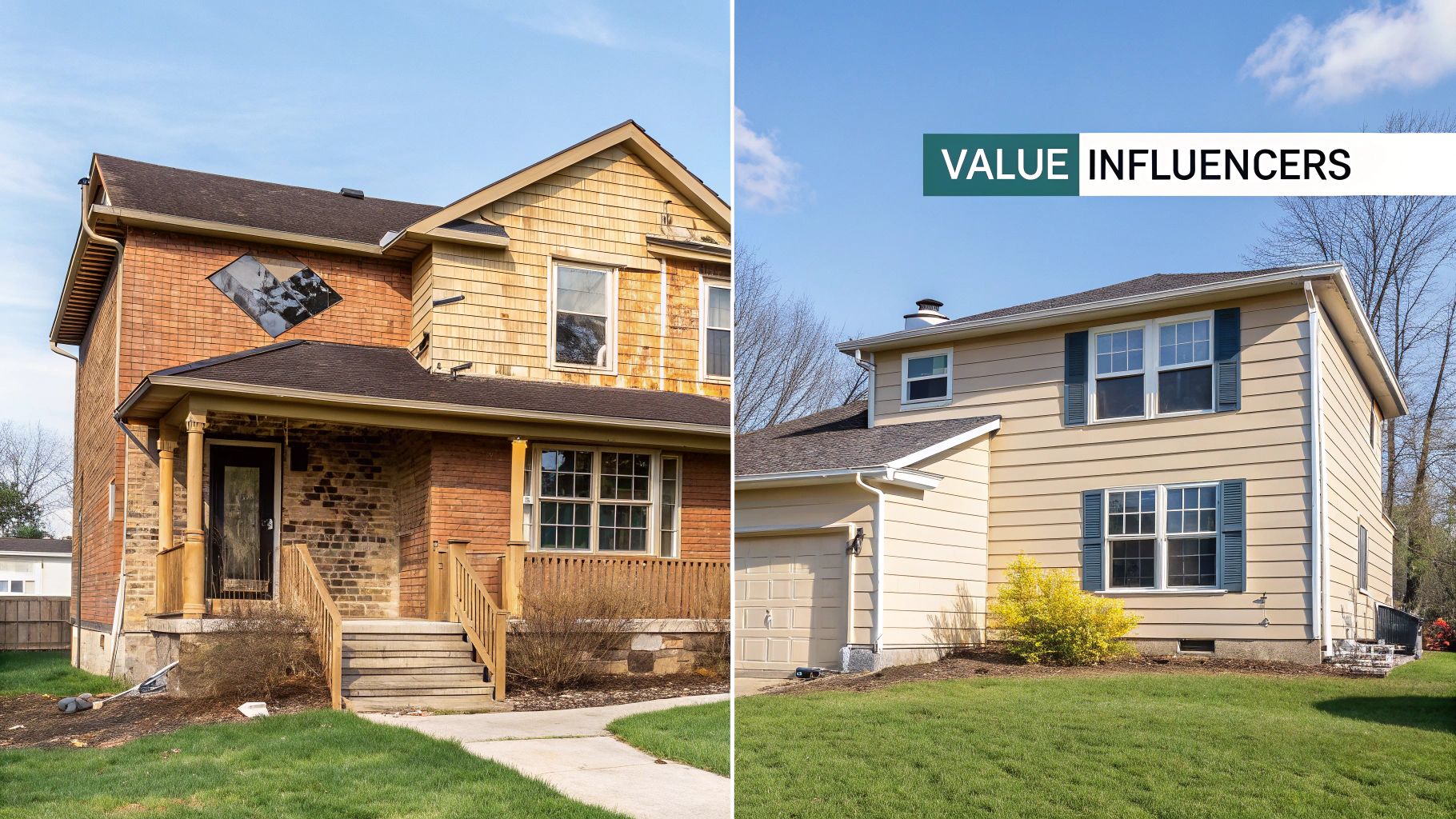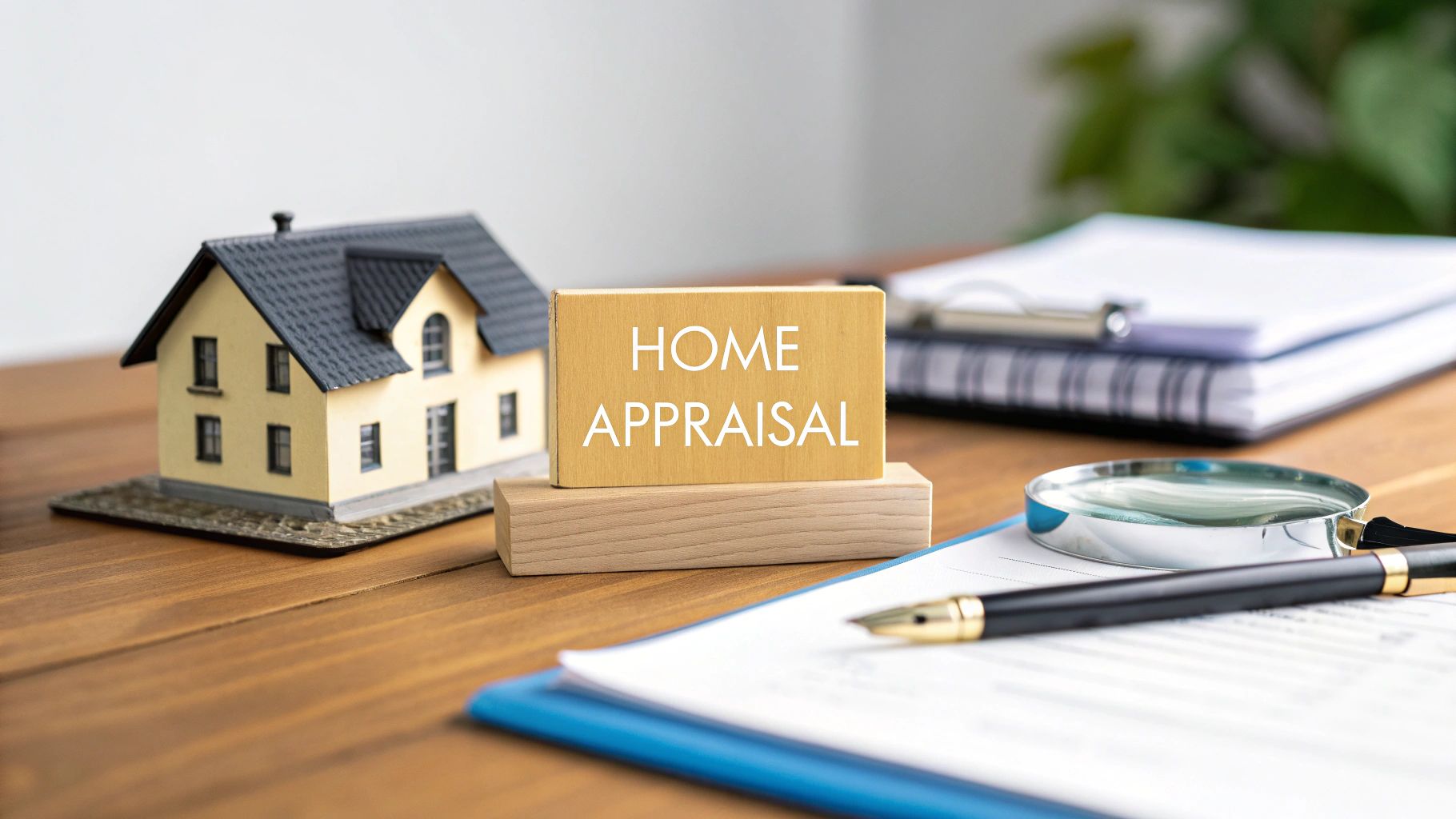At its heart, an appraisal is simply an expert’s professional opinion on what something is worth. It’s a formal process used to figure out an asset's value in today’s market.
This kind of professional assessment is a crucial step for big financial moments, like buying a house, getting a loan, or figuring out the value of an antique for insurance or sale. It gives you a credible, fact-based valuation you can trust.
What an Appraisal Is and Why It Matters

Think of an appraisal as a professional check-up for an item's value. It's an unbiased, well-researched judgment call made by a qualified appraiser. This process cuts through the noise of guesswork and sentimental value to land on a solid number, backed by proven methods and real market data.
Whether it’s a sprawling estate, a piece of modern art, or a cherished family heirloom, the goal is always the same: to pin down its fair market value. And that number is absolutely critical in a lot of high-stakes situations.
The Real-World Impact of an Appraisal
So, why does a formal valuation matter so much? An appraisal provides the essential information that protects everyone involved in a transaction or financial decision.
Here are a few common scenarios where an appraisal is non-negotiable:
- Buying or Selling: It helps set a fair price, so buyers don't overpay and sellers don't get short-changed.
- Securing a Loan: Banks and lenders need an appraisal to confirm a property is worth enough to secure the mortgage.
- Insurance Coverage: It provides the proof needed to insure an item for its actual replacement cost.
- Estate Planning: An appraisal is key for dividing assets fairly among heirs and for handling taxes correctly.
This process is so fundamental that the global real estate appraisal market is a huge industry. In 2025, it hit a worldwide revenue of $31.8 billion, which just goes to show how vital it is for property and loan deals.
An appraisal isn't just a formality; it's a tool for financial clarity. It replaces subjective feelings with objective facts, empowering you to make informed decisions with confidence and reducing risk in significant financial moments.
To give you a quick snapshot, here’s a simple breakdown of what an appraisal involves.
The Appraisal Process at a Glance
| Component | Description |
|---|---|
| Who | A certified, impartial appraiser with expertise in the specific type of asset. |
| What | A detailed examination of the asset's condition, features, and marketability. |
| When | During sales, loan applications, insurance updates, estate settlements, or legal disputes. |
| Why | To establish an objective, defensible, and credible valuation for financial decisions. |
This table shows how an appraisal brings together the right person, a thorough process, and a clear purpose to arrive at a trustworthy value.
Ultimately, the entire point is to figure out what an asset would likely sell for in a normal, competitive market. For a deeper dive into this key idea, our guide on what is fair market value breaks it all down. If you’re focused on real estate, this guide on What Is a Property Appraisal in Australia? is a great resource for understanding how home values are calculated. With this foundation, we can start looking at the specific methods appraisers use to work their magic.
The Three Core Methods of Valuation

So, how exactly does an appraiser land on a final number after looking over an item? It's not guesswork. They rely on three well-established methods to determine value. Think of these as different lenses to look through, each one giving a unique perspective on what something is worth.
Most of the time, a good appraiser won't just stick to one method. They'll often use a combination of these approaches to build the most complete picture. By weighing the results from each, they can zero in on a final value that's both accurate and easy to justify.
Let's dig into what these methods are and how they work.
The Sales Comparison Approach
This is the one you’re probably most familiar with, especially if you’ve ever bought or sold a house. At its heart, the Sales Comparison Approach is simple: what have similar things sold for recently? It’s all about understanding what the current market is willing to pay.
An appraiser hunts down recent sales of items that are as close as possible to the one they’re evaluating. These are called "comparables," or "comps" for short. The trick is then to adjust for the differences between the comps and your item.
- Example: Let's say you're appraising a vintage oak dining table. The appraiser finds three similar tables that sold in the last six months. One of them had a pristine, refinished top, so its price is adjusted downward to match the condition of your table. Another had a slight wobble, so its price gets adjusted upward. This fine-tuning process helps create a level playing field, revealing a realistic market value.
This approach is powerful because it's grounded in real-world, recent transactions. It’s a direct reflection of what buyers are actually doing right now.
The Cost Approach
But what about one-of-a-kind items? Think of a custom-commissioned sculpture or a piece of architecture with no direct parallels. When there are no "comps" to be found, appraisers turn to the Cost Approach.
This method asks a different question: what would it cost to create this exact same item from scratch today?
The formula is pretty logical:
- Calculate Replacement Cost: First, the appraiser figures out the cost of the raw materials and the labor required to build an exact replica.
- Subtract Depreciation: Next, they subtract value for any wear and tear, age, or outdated features (what appraisers call "obsolescence").
The idea here is that a rational buyer wouldn't pay more for a used item than the cost of commissioning a brand-new one.
This approach works best for newer or unique items where estimating the cost to reproduce them is straightforward. For very old antiques, calculating depreciation accurately can be tricky, so this method is often used alongside others.
The Income Approach
The third tool in the toolbox is for items that generate money. This could be anything from a vintage, coin-operated jukebox to a piece of art that’s frequently rented out to galleries. The Income Approach values an asset based on the cash flow it produces.
An investor looking at an antique rental property, for instance, cares most about its potential profit. An appraiser using this method will analyze the income it brings in, subtract the costs of maintenance and upkeep, and then calculate its value based on that net income.
Ultimately, this approach ties an item's value directly to its ability to make money. It's all about the bottom line.
What Really Shapes Your Appraisal Value?

Think of an appraisal as more than just a quick walk-through. A good appraiser is like a detective, meticulously gathering clues to determine what a property is truly worth. This is why two houses that seem nearly identical on paper can have drastically different appraised values.
It’s all in the details. The appraiser’s job is to see beyond the surface, analyzing everything from the home’s condition to its place in the current market. Let's pull back the curtain and look at what they’re really focused on.
Inside the Four Walls: The Property Itself
The most obvious starting point is the home’s physical condition and features. This is where an appraiser spends a lot of their time, documenting the good, the bad, and the in-between.
Age and Condition: That brand-new roof isn't just for looks; it’s a major plus in an appraisal. On the flip side, an aging HVAC system or outdated plumbing can be a significant liability. Appraisers look closely at the lifespan and functionality of all major systems.
Upgrades and Renovations: A thoughtfully renovated kitchen with quality finishes can seriously boost value. A 1980s-era kitchen with worn-out cabinets? Not so much. It's not just that you renovated, but how well it was done.
Layout and Flow: Square footage isn't everything. A home with a clunky, impractical layout or a serious lack of storage can lose points, even if it's spacious. Today's buyers—and appraisers—value a floor plan that makes sense for modern life.
These internal characteristics form the foundation of the appraisal value.
Looking Outside: Location and Market Forces
A property is only worth what someone is willing to pay for it, and that’s heavily influenced by factors well beyond the front door. A house doesn't exist in a bubble; its surroundings and the broader economic climate are a huge part of the equation.
An appraiser will zoom out to look at the neighborhood. Are the schools good? Is it close to parks and amenities? Or is it next to a noisy highway? These all move the needle.
The big picture matters, too. An appraiser has to factor in supply and demand, current interest rates, and the overall health of the real estate market. These forces can push values up or down, regardless of a home's condition.
This is where expert real estate appraisal services become so important, especially when the market is shaky. For instance, global real estate investment volumes dropped by 2% year-over-year in 2025, a shift tied to wider economic pressures. As you can learn from in-depth analysis from experts like UBS, these global trends have a direct impact on your local property value.
First Impressions Matter: Curb Appeal
You only get one chance to make a first impression, and it’s no different with an appraisal. Curb appeal is the feeling someone gets when they first pull up to the property, and it sets the tone for the entire valuation.
A well-kept exterior sends a powerful signal that the inside is probably in good shape, too. This includes things like:
- Neat landscaping and a mowed lawn
- Fresh, clean paint or siding
- An inviting front entryway
- A driveway that isn't cracked and crumbling
While appraisers are trained professionals who rely on data, they're also human. A property that clearly shows pride of ownership almost always leaves a stronger, more positive impression.
The table below breaks down how some of these common factors can swing an appraisal in either direction.
Impact of Common Factors on Property Appraisal
| Factor | Potential Positive Impact | Potential Negative Impact |
|---|---|---|
| Location | Proximity to good schools, parks, and shopping centers. Located in a low-crime area. | Near industrial zones, noisy highways, or undesirable facilities. High crime rates. |
| Condition | Newly installed roof, updated HVAC, and modern plumbing/electrical systems. | Aging systems, evidence of leaks or structural issues, deferred maintenance. |
| Renovations | Modern kitchen and bathrooms with high-quality materials and professional workmanship. | Outdated styles, DIY renovations of poor quality, or unpopular design choices. |
| Curb Appeal | Manicured lawn, fresh paint, clean walkways, and attractive landscaping. | Overgrown yard, peeling paint, cracked driveway, and a cluttered exterior. |
| Market | High buyer demand, low inventory, and falling interest rates (a "seller's market"). | High inventory, low buyer demand, and rising interest rates (a "buyer's market"). |
Ultimately, a credible appraisal is a blend of all these elements—the internal, the external, and the overall presentation—to arrive at a final, defensible value.
How to Prepare for a Home Appraisal

While you can’t exactly pick up your house and move it to a better location, you absolutely have some control over its appraisal. Getting ready for an appraiser’s visit isn’t about trickery or hiding flaws. It’s about making sure your home’s best features shine through, so the appraiser gets a full, accurate picture of its value.
Think of it like getting ready for a big job interview. You'd get a haircut, press your best shirt, and have your resume handy to highlight your accomplishments. A little prep work for your home works the same way—it can make a real difference in the final number and give you confidence in the outcome.
Create a Homeowner's Brag Book
One of the smartest things you can do is put together a folder with all the key info about your home. You're essentially doing some of the appraiser's homework for them, making it easy to see the investments you've poured into the property.
Your "brag book" should be a simple binder that includes:
- A List of Major Improvements: Jot down any big upgrades you’ve done in the last 5-10 years. Think new roof, updated HVAC system, energy-efficient windows, or a kitchen remodel. Be sure to include the year and approximate cost.
- Supporting Documents: Back it up with proof. Toss in copies of receipts, building permits, or warranties for the work you've had done. This shows the quality and legitimacy of the upgrades.
- Neighborhood Perks: If a new coffee shop just opened on the corner or the local school's rating just went up, make a note of it! These local improvements add value.
This little packet provides hard data that an appraiser might not spot during a quick walkthrough.
An appraiser's time at your property is limited. A well-organized file of upgrades helps them build a thorough report and ensures that no value-adding feature gets missed. It also shows you’re a proud, diligent homeowner.
Tackle Minor Repairs and Boost Curb Appeal
Take a walk through your house and try to see it through a stranger's eyes. All those little quirks you've gotten used to—a squeaky door, a drippy faucet—can add up to an impression of neglect. Fixing them is one of the easiest, cheapest ways to make a big impact.
Focus on the small stuff:
- Fix Leaky Faucets: That constant drip might signal bigger plumbing problems to an appraiser.
- Repair Sticky Doors or Broken Latches: Everything in the home should work as intended.
- Replace Burnt-Out Lightbulbs: A bright, well-lit space feels bigger and better maintained.
- Touch Up Chipped Paint: A few dabs of paint can make a room look clean and fresh.
Don’t forget that the first impression happens before they even step inside. Mow the lawn, trim the bushes, and make sure the entryway is clean and welcoming. A great first impression sets a positive tone for the rest of the visit.
For a deeper dive, this essential checklist for a smooth home appraisal process is a fantastic resource. And if your home is full of unique collections, getting an expert opinion on your belongings through an antique appraisal near me can also help you understand the total value you're sitting on.
How to Read Your Final Appraisal Report
Getting an appraisal report can feel a bit like being handed a complex legal document. It’s dense, filled with industry jargon, and can be intimidating. But once you know how to break it down, it starts to tell a clear story about your item’s history and value.
Think of it as a detailed biography of your antique. Each section adds another layer to the story, from its physical condition to how it stacks up against similar items in today's market. You just need to know where to find the key chapters.
Locating the Core Information
Let's be honest, the first thing everyone looks for is the final number. You can usually find the final appraised value right on the first or second page. This is the appraiser's official opinion of what your piece is worth.
Next, you'll want to find the section on comparable sales, often called "comps." This is the heart of the appraisal. Here, the appraiser lays out the evidence, showing you a list of similar items that have sold recently. They then adjust the prices of those comps based on how they differ from your item—maybe yours is in better condition or has a more unique feature—to arrive at that final value.
A credible appraisal report is built on transparency. Its primary function is not just to state a value but to show the data-driven work that led to that conclusion, providing a clear and defensible analysis.
After you’ve digested the value and the comps, scan the report for the appraiser's notes and commentary. Look for specific comments on your item’s condition, any unique characteristics, or potential issues that could affect its value. These notes are incredibly valuable because they explain the why behind the number, highlighting the factors that either helped or hurt the final valuation.
What to Do with a Low Appraisal
What if the appraisal comes in lower than you hoped? It’s a deflating feeling, for sure, but don't panic. You have options. The key is to approach the situation calmly and methodically.
First, go through the report with a fine-tooth comb and check for any factual errors.
- Are the dimensions and weight correct?
- Did the appraiser misidentify a material or maker's mark?
- Were any significant restorations or unique features overlooked?
If you spot a clear mistake, you can challenge the appraisal through a process called a Reconsideration of Value. This involves submitting a formal request, backed by clear documentation of the errors you found. You might also provide your own research on comparable sales that you believe the appraiser missed.
The trick is to present a calm, fact-based argument. While there’s no guarantee an appraiser will change their valuation, giving them solid evidence is your best shot at getting them to take a second look.
Common Questions About the Appraisal Process
Stepping into the world of appraisals can feel a little like learning a new language. There are specific terms, distinct steps, and it's easy to feel a bit lost. It's completely normal to have questions, especially when you're making important decisions about valuable items.
Let’s clear up some of the most common questions people have. Getting straight answers will help you feel more confident and in control of the process.
How Long Does an Appraisal Take and How Much Does It Cost?
This is usually the first thing on everyone's mind, and for good reason. The actual on-site inspection is surprisingly quick, often taking just 30 to 60 minutes for a standard single-family home. But that's just the tip of the iceberg.
The real work happens after the appraiser leaves. They’ll spend several hours digging into market data, finding comparable sales, and compiling a detailed report. All in all, you should expect to see the final report in your hands anywhere from a few days to two weeks later.
What about the cost? It really depends on your location and the complexity of what's being appraised. For a typical home, you're looking at a range of $300 to $600. Naturally, a larger, more unique property with unusual features will command a higher fee. If you want to dive deeper, you can learn more about the factors that influence antique appraisal cost and see how those principles apply more broadly.
What Is the Difference Between an Appraisal and an Inspection?
This is a big one, and it's a critical distinction to understand. People mix these up all the time, but they serve two totally different functions.
An appraisal is all about determining market value for a lender. An inspection is about assessing physical condition for a buyer. The appraiser is focused on worth; the inspector is focused on what’s working and what’s broken.
Here’s a simple way to think about it:
- The Appraiser asks, "What is this property worth in today's market?" They look at the big picture—size, features, location, and overall condition—to arrive at a dollar figure. Their report is mainly for the bank.
- The Inspector asks, "What problems should I know about before buying?" They get into the nitty-gritty, testing the plumbing, electrical, HVAC, and checking the roof and foundation for any issues. Their report is for your protection.
Can the Appraisal Be Lower Than the Sale Price?
Absolutely. When this happens, it's called an "appraisal gap," and it’s not uncommon, especially in a hot real estate market where bidding wars push prices up.
If an appraisal comes in low, the lender will only finance the loan up to the appraised value—not the higher price you agreed to pay. This leaves you with a shortfall that needs to be covered.
So, what do you do? You have a few choices:
- The buyer can make up the difference in cash.
- The seller can lower the sale price to match the appraisal.
- Both sides can meet in the middle and negotiate a new price.
Thankfully, most purchase contracts have an appraisal contingency built in. This clause gives the buyer a way out of the deal without losing their deposit if a solution can't be found.
Ready to uncover the history and value of your own treasures? With the Curio app, you get an antique expert in your pocket. Just snap a photo to instantly identify items, learn their stories, and get a quick appraisal. Download it today and let your antiques tell their story at https://www.curio.app.
